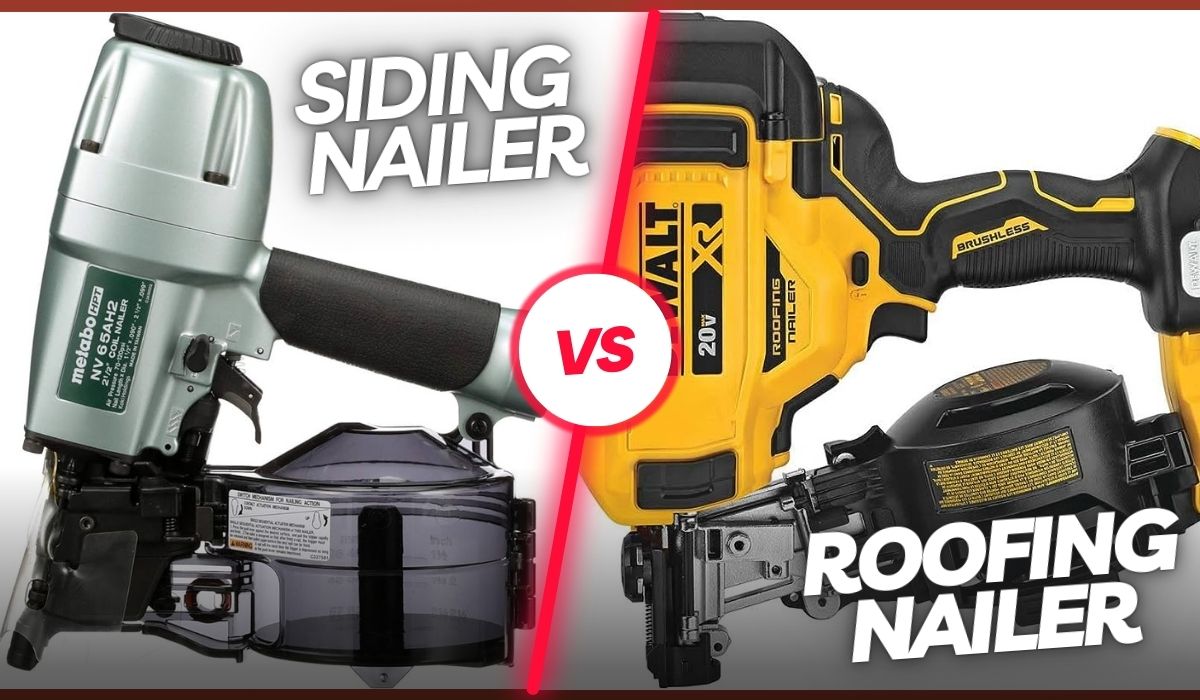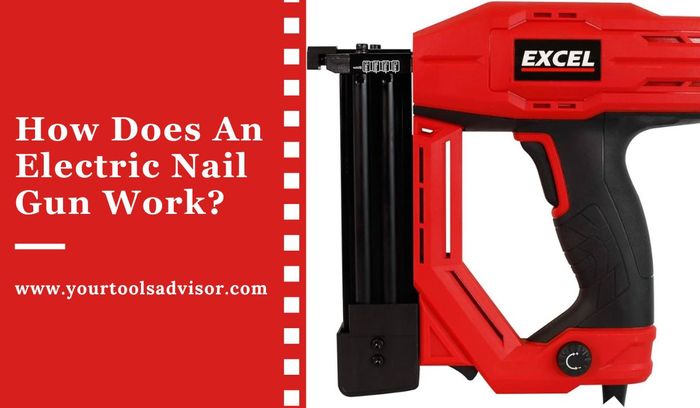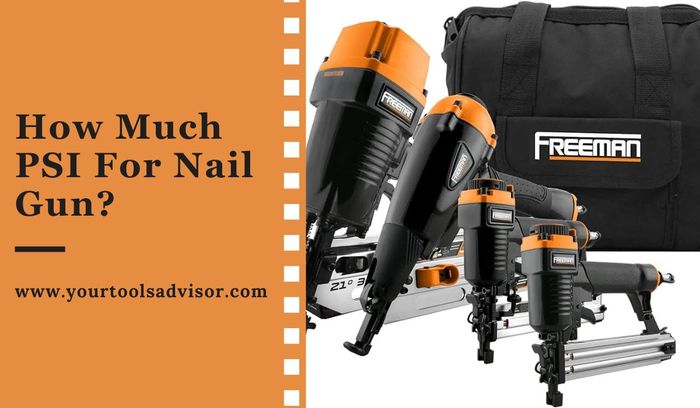When it comes to tackling exterior home improvement projects, having the right tools at your disposal can make all the difference. For tasks like installing siding or roofing, the choice between a siding nailer and a roofing nailer can be a critical one.
Each of these specialized tools serves a specific purpose, and understanding their differences can save you time, effort, and ultimately, ensure a professional finish.
It is to be noted that it is important to understand the differences between these two tools to make an informed decision. You need to keep in mind that both siding nailers and roofing nailers play a crucial role in construction and woodworking projects, but they are designed for specific tasks.
In this comprehensive guide, we’ll break down the key distinctions between siding nailers and roofing nailers, helping you make an informed decision based on your project requirements.
Whether you’re a seasoned DIY enthusiast or a professional contractor, this knowledge will empower you to choose the perfect tool for the task at hand.
So, let’s dive in and explore the nuances of these essential nailers, ensuring your next exterior project is a resounding success…
Function And Purpose Of Siding Nailer
A siding nailer is a powerful tool designed specifically for fastening siding materials to the exterior of a building. It uses specialized nails that are long and slender, with a small head that can be easily concealed within the material. The primary function of a siding nailer is to provide a quick, efficient, and secure method for installing siding, such as vinyl, fiber cement, or wooden panels.
Definition And Explanation Of Siding Nailer
A siding nailer is a pneumatic tool that operates using air pressure from a compressor, although there are also cordless models available. It features a magazine that holds the nails and an adjustable depth setting to control the nail’s penetration depth. The nails are loaded into the magazine and fed through a firing mechanism, which drives the nail into the siding material with great force and speed.
Applications And Uses of Siding Nailer
Siding nailers are commonly used in construction and remodeling projects for installing and repairing various types of siding. They excel at securing large, heavy panels quickly, saving time and effort compared to manual nailing. Siding nailers are versatile tools that can be used for residential, commercial, and industrial applications, making them invaluable for professionals and DIY enthusiasts alike.
Benefits And Advantages Of Using A Siding Nailer
The use of a siding nailer offers several advantages, such as improved productivity due to faster installation, reduced fatigue for the user, and enhanced precision and consistency in nail placement. The adjustable depth setting allows for precise control over the nail’s depth, preventing overdriving or underdriving. Additionally, siding nailers often have a sequential or bump fire mode, which further increases efficiency by allowing rapid, continuous firing without releasing the trigger.
What Is The Function And Purpose Of A Roofing Nailer?
A roofing nailer is specifically designed to install roofing materials, while a siding nailer is used for siding installation. The purpose of a roofing nailer is to efficiently and securely attach shingles or other roofing materials to the roof, making the installation process faster and more convenient.
A roofing nailer is a specialized tool designed specifically for installing shingles or roofing materials onto a roof surface. It is a powerful pneumatic tool that uses compressed air to drive roofing nails into the surface, providing a secure and efficient method of attaching roofing materials.
Definition and explanation of roofing nailer
A roofing nailer is a type of nail gun that is specifically designed for roofing applications. It is lightweight and easy to handle, allowing for quick and precise installation of roofing materials.
Applications and use cases for roofing nailer
- Installing asphalt shingles
- Attaching roof felt or underlayment
- Applying cedar shakes or wooden shingles
- Securing metal roofing materials
Benefits and advantages of using a roofing nailer
- Increased productivity and efficiency
- Reduced fatigue and strain on the user
- Consistent and accurate installation
- Less risk of damage to roofing materials
- Time and cost savings
Key Differences Between Siding Nailer And Roofing Nailer
The major differences between a siding nailer and a roofing nailer lie in their features, specifications, and functionality.
| Comparison | Siding Nailer | Roofing Nailer |
|---|---|---|
| Nail Size and Collation Method | Typically uses shorter nails with larger collation, such as wire or plastic collation. | Uses longer nails with a smaller collation, usually coil collation to accommodate larger quantities. |
| Handling and Usability Differences | Designed for precision and accuracy on vertical surfaces, making them ideal for siding installation. | Configured for rapid and repetitive nailing on horizontal surfaces like roofs, facilitating quick installation. |
| Material Compatibility and Suitability | Suitable for attaching siding materials like vinyl, wood, or fiber cement boards. | Primarily used for fastening shingles, asphalt, or other roofing materials. |
Understanding these differences is crucial to selecting the right nailer for your specific project. Ensure that you consider factors such as the type of material, surface orientation, and desired nail size before making a decision. By choosing the appropriate tool, you can achieve efficient and effective results.
Factors To Consider When Choosing Between Siding Nailer And Roofing Nailer
Project Requirements and Type of Work: The first factor to consider is the specific project requirements and the type of work you will be undertaking. Evaluate whether you need the nailer for siding installation or for roofing projects, as these tasks may require different features and functionalities.
Budget and Cost Considerations: Another crucial aspect to ponder is your budget and cost considerations. Determine how much you are willing to invest and compare the pricing options of both types of nailers. Consider the long-term benefits of each tool and the potential savings it can provide.
Durability and Reliability: When investing in a nailer, it is important to assess the durability and reliability of the tool. Look for sturdy construction materials, reputable brands, and read customer reviews to gauge the overall quality and reliability of the nailer.
Safety Features and Ease of Use: Lastly, prioritize safety features and ease of use. Look for nailers that include safety mechanisms to prevent accidental firing or injuries. Additionally, consider the ergonomic design, weight, and ease of handling, as these factors can greatly impact your efficiency and comfort while working.
Advantages and Benefits of Roofing Nailer
- Efficiency: A siding nailer can nail siding quickly and efficiently, saving time and effort in the process.
- Precision: It allows for precise and accurate nailing, ensuring a secure and professional finish.
- Versatility: Siding nailers can be used for various siding materials, such as vinyl, fiber cement, wood, and more.
- Reduced damage: The siding nailer’s design minimizes the risk of splitting or damaging the siding material.
- Increased safety: These nailers often come with safety features that protect the user from accidental firing.
Limitations and Drawbacks of Using a Siding Nailer
- Cost: Siding nailers can be more expensive compared to regular nail guns.
- Specialized use: They are primarily designed for siding projects and may not be as versatile for other woodworking tasks.
- Weight: Some siding nailers can be heavier and bulkier, which may cause fatigue during extended use.
- Noise: Siding nailers can produce loud noises during operation, requiring ear protection for prolonged use.
- Requires air compressor: Many siding nailers require an air compressor to power them, adding additional equipment costs.
Advantages and Benefits of Roofing Nailer
- Efficiency: One of the major benefits of using a roofing nailer is its efficiency. The tool allows for fast and accurate nailing, reducing the time and effort required for roofing installation.
- Precision: Roofing nailers offer precise nail placement, ensuring a secure attachment of shingles or other roofing materials. This helps to prevent leaks and increase the overall durability of the roof.
- Reduced fatigue: Roofing can be a physically demanding task. However, using a nailer reduces hand fatigue, allowing roofers to work for longer periods without discomfort.
- Safety: Roofing nailers are designed with safety features such as depth adjustment and trigger locks, minimizing the risk of accidental injuries during usage.
Limitations and Drawbacks of Roofing Nailer
- Cost: Investing in a roofing nailer can be expensive, particularly for DIYers or homeowners who only require occasional roofing repairs.
- Noise: Roofing nailers can be noisy during operation, which may disturb residents or workers in the vicinity. Ear protection is recommended.
- Complexity: Learning to use a roofing nailer correctly requires practice and familiarity with the tool. Improper usage can lead to mistakes, such as overdriven or underdriven nails.
Best Practices For Using A Siding Nailer
A siding nailer is a powerful tool that requires proper handling and caution to ensure safety and efficiency. Here are some important tips and techniques to keep in mind:
Safety Precautions And Guidelines
- Always wear appropriate safety gear such as safety glasses, gloves, and ear protection.
- Inspect the nailer before each use to ensure it’s in good working condition.
- Keep your hands and fingers away from the nailer’s firing mechanism.
- Securely fasten the workpiece to prevent movement during nailing.
- Never point the nailer at anyone, even when it’s not being used.
Tips And Techniques For Optimal Performance
- Choose the right nails for the job, considering length, gauge, and material.
- Hold the nailer firmly and position it correctly for accurate and consistent nail placement.
- Practice proper sequencing and rhythm to avoid jams and misfires.
- Adjust the nailer’s depth settings according to the materials being used.
- Take breaks as needed to prevent overheating of the nailer.
Maintenance And Cleaning Recommendations
- Regularly clean the nailer’s magazine and remove any debris or buildup.
- Keep the nailer well-lubricated to ensure smooth operation.
- Store the nailer in a clean and dry place when not in use.
- Follow manufacturer’s instructions for any additional maintenance and servicing.
By following these best practices, siding nailer users can enhance both their safety and the overall performance of the tool.
Best Practices For Using A Roofing Nailer
When using a roofing nailer, it is crucial to follow safety precautions and guidelines to avoid accidents and injuries. These include wearing protective gear such as safety glasses and gloves, ensuring a stable and secure footing, and keeping hands and fingers away from the nailer’s firing area.
Additionally, practicing tips and techniques can help achieve optimal performance. This includes holding the nailer at the correct angle (usually 45 degrees), applying consistent pressure on the tool, and positioning the nails accurately on the material. Avoid overdriving or underdriving the nails, as this may compromise the integrity of the roofing material.
Maintenance and cleaning are also vital for the longevity of the roofing nailer. Regularly inspect the tool for any damages or worn-out parts. Clean the nailer after each use to remove debris and ensure smooth operation. Lubrication of moving parts should be carried out as per the manufacturer’s recommendation.
Frequently Asked Questions Of Siding Nailer Vs Roofing Nailer
What Is A Siding Nailer Used For?
A siding nailer is used to fasten siding materials, such as vinyl, wood, or fiber cement, to the exterior walls of a building. It provides a secure and efficient way to install siding, ensuring a professional and finished look.
What Is A Roofing Nailer Used For?
A roofing nailer is specifically designed for roofing projects. It is used to fasten shingles or roofing materials to the roof deck, creating a weatherproof barrier. Roofing nailers are faster and more accurate compared to traditional hand nailing methods.
Can I Use A Siding Nailer For Roofing?
While it is technically possible to use a siding nailer for roofing, it is not recommended. Siding nailers are not designed to withstand the demanding conditions and requirements of roofing projects. It is best to use a roofing nailer specifically designed for that purpose to ensure proper installation and longevity of the roof.
Can I use roofing nailer for siding?
Yes, you can use a roofing nailer for siding, but it’s not the ideal tool. Roofing nailers are designed for thicker and denser materials, so they may not provide the best results for siding which is typically thinner. It’s recommended to use a siding nailer for optimal performance and to ensure a secure and proper installation.
What’s the difference between a roofing coil nailer and a siding coil nailer?
A roofing coil nailer is designed for fastening shingles or roofing material to a roof deck, typically using shorter nails with a wide head.
On the other hand, a siding coil nailer is meant for attaching siding material to a building’s exterior, using longer nails with a smaller head to ensure a secure but inconspicuous attachment.
The main distinction lies in the nail length, head size, and the intended application for each type of nailer.
What is special about a siding nailer?
A siding nailer is specially designed for fastening siding materials to a structure. It features a narrow, angled nose that allows for precise placement of nails, minimizing damage to the siding surface. Additionally, siding nailers typically use corrosion-resistant nails to ensure the longevity of the installation.
Conclusion
In conclusion, when it comes to choosing between a siding nailer and a roofing nailer, it’s important to consider the specific tasks at hand. While both tools may seem similar at first glance, they serve distinct purposes in the realm of construction and carpentry.
A siding nailer is ideal for attaching siding materials to the exterior of a building, providing precision and efficiency in this specialized task. On the other hand, a roofing nailer is specifically designed for fastening shingles and roofing materials, offering the power and durability needed to tackle roofing projects with ease.
Ultimately, selecting the right nailer for your project will greatly enhance your efficiency and the quality of your work.
It’s crucial to evaluate the requirements of your specific job and choose the nailer that aligns best with those needs.
By doing so, you’ll ensure a smoother, more successful construction process, ultimately leading to a finished product that stands the test of time.





Leave a Reply